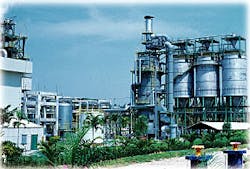New Thailand ethylene plant commissioned
Siam Mitsui PTA's purified terephthalic acid (PTA) plant started up in February. Cementhai Chemical Co., part of Siam Cement Group, and Mitsui Chemical Inc., one of the world's largest PTA producers, each owns 49% of Siam Mitsui PTA. SMH holds a 2% stake.Thailand's third world-scale olefins complex came onstream in February, making the country a dominant player in the Southeast Asian petrochemical industry while aggravating the oversupply situation, especially in Thailand.
The new olefins plant, owned by Rayong Olefins Co. Ltd. (ROC), can produce 600,000 metric tons/year (mty) of ethylene and 300,000 mty of propylene. ROC plans to step up its capacity utilization from 70-80% in February to 100% in March.
Siam Cement Group owns 65.5% of the $620 million olefins plant.
ROC's advantage
Additional output from ROC will raise Thailand's overall olefins production capacity to more than 2.8 million tons in 2000. Domestic supply will exceed domestic demand, which is projected to grow by 2-3% this year, forcing producers to boost exports, said analysts at the Bangkok Bank.Apiporn Pasawat, vice-president for petrochemicals of Siam Cement, estimated that the commissioning of this new plant will cause a surplus of 70,000 tons of ethylene and 10,000 tons of propylene in Thailand.
The presence of ROC is increasing pressure on the country's other two olefins crackers, owned by National Petrochemical plc (NPC) and Thai Olefins Co. (TOC), to match prices. Consulting firms Goldman Sachs and McKinsey & Co. Inc. suggested that ROC has a competitive edge, with probably the lowest cost in Asia, at only $195/ton. NPC's production cost is estimated at $230/ton and TOC's cost is estimated at $203/ton.
Lower olefins production costs by ROC is a result of lower feedstock prices; the plant uses naphtha feed. The lowered costs, said Apiporn, will result in further cost efficiencies in the production of intermediate and downstream petrochemical products.
The cyclical downturn of the world's petrochemical industry is expected to last until 2002. "With integration," said Apiporn, "we can easily survive the downturn in the next 3 years."
Although the group is not making any new investment over the next 3 years as a result of the economic downturn, the executive talked about expanding existing facilities via debottlenecking to achieve higher economies of scale for ROC.
Future debottlenecking would cost about $50 million and expand ROC's production capacity by 10-20%, raising ethylene capacity to about 720,000 tons. The expansion project is expected to be done in 2002, timed to coincide with the market upturn, according to Apiporn.
Integration with downstream units
Several new downstream plants were commissioned in February. These plants and facilities were undertaken by Siam in the form of joint ventures with other companies:- Siam Polyethylene's low density polyethylene (LDPE) plant
- Siam Mitsui PTA's purified terephthalic acid (PTA) plant
- Thai's methyl methacrylate (MMA) plant
- PT Siam Manspion Polymers' PVC resin plant
- PT Siam Manspion Terminal's tank farm and jetty terminal.
The plan, unveiled by Hayato Yonemori, managing director of Siam Mitsui PTA, stems from the joint venture's expected recovery of Thailand's textile industry which uses PTA as a raw material.
If realized, Siam Mitsui PTA would become the country's largest PTA maker, overtaking Tuntex Thailand, part of Taiwan-based Tuntex, which currently has a production capacity of 420,000 tons of PTA at its Mab Ta Phud plant in Rayong.
Siam Mitsui PTA expects a difficult business this year as a result of an expected surplus of about 50,000 tons of PTA supplies in the domestic market and a slump in PTA prices. Mitsui, however, can absorb some of the surplus by exporting it to Pakistan, Turkey, and the Middle East.
"We know the industry is at its worst and both of us will have to ensure the survival of our PTA plant," said Yonemori. He believes that current PTA prices have reached their lowest level at $350/ton and should begin to slowly climb in the third quarter of this year.
Copyright 1999 Oil & Gas Journal. All Rights Reserved.
